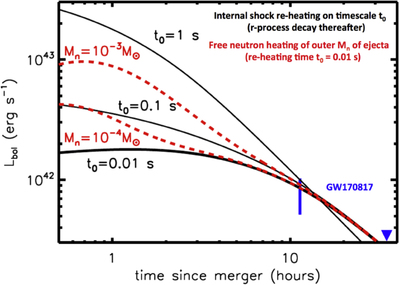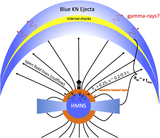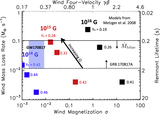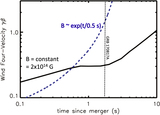Image Details

Caption: Figure 3.
Bolometric light curve of the blue KN emission during the first few hours after the merger, calculated for several models that reproduce the measured luminosity ﹩{L}_{\mathrm{bol}}\approx {10}^{42}﹩ erg s−1 of GW170817 at t ≈ 11 hr (blue uncertainty bar; e.g., Arcavi et al. 2017; Cowperthwaite et al. 2017; Drout et al. 2017). Black solid lines show models for different assumptions about the timescale t0 = 0.01, 0.1, 1 s following ejection at which the matter was last thermalized, i.e., possessed an internal thermal energy comparable to its asymptotic kinetic energy (for t ≥ t0, the heating is solely due to r-process radioactivity). A small value of t0 ≲ 0.01 s corresponds to a dynamical ejecta origin with no additional heating, while a large value of t0 ≳ 0.1–1 s represents the case of a long-lived engine (magnetar wind or accretion disk outflow), where the outflow properties vary over timescales ≈t0. We have assumed KN parameters (see the Appendix): β = 3, v0 = 0.25c, Mtot = 0.025M⊙, κ = 0.5 cm2 g−1 (except for the t0 = 1 s case, for which Mtot = 0.015M⊙). Red dashed lines show models with t0 = 0.01 s in which the outer 10−3M⊙ or ﹩{10}^{-4}{M}_{\odot }﹩ of the ejecta contain free neutrons instead of r-process nuclei (Metzger et al. 2015), showing how the enhanced luminosity from neutron decay (the “neutron precursor”) is degenerate with large thermalization times.
Copyright and Terms & Conditions
© 2018. The American Astronomical Society. All rights reserved.






